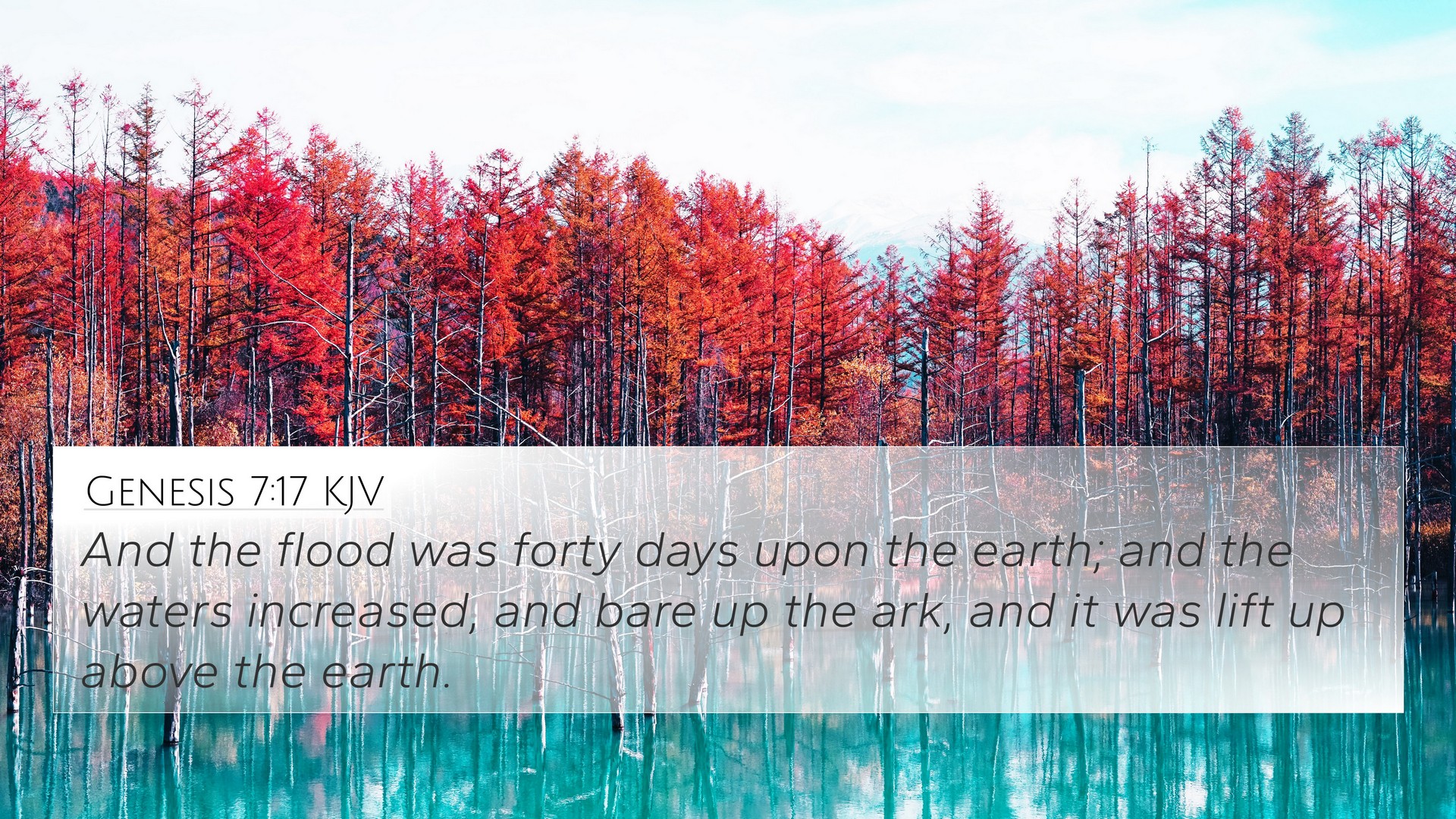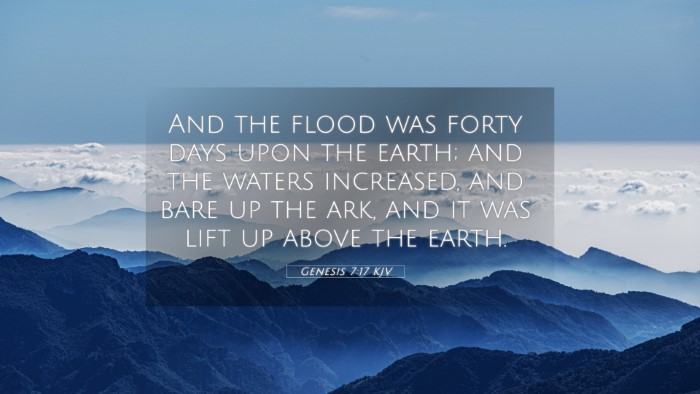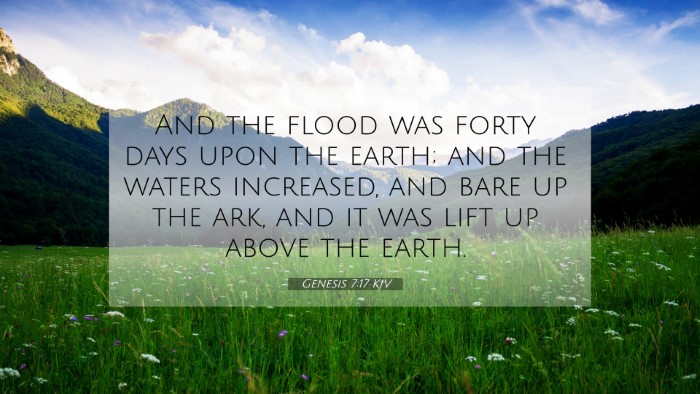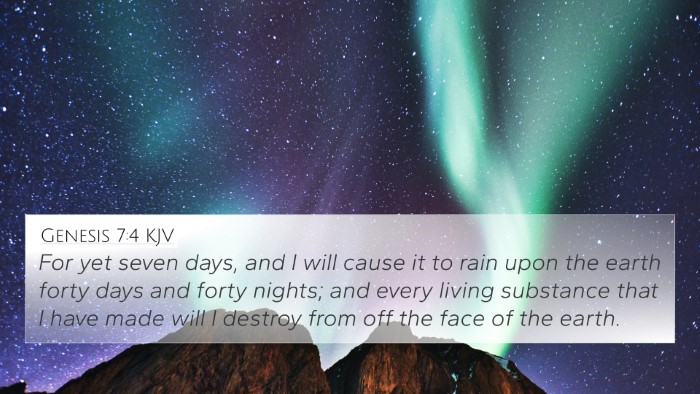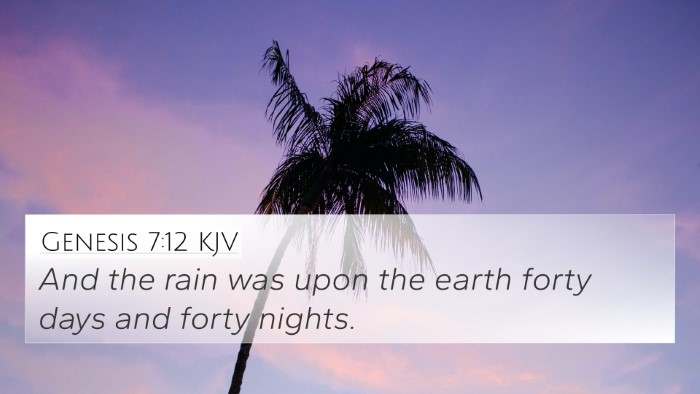Understanding Genesis 7:17
Genesis 7:17 states: "And the flood was forty days upon the earth; and the waters increased, and bare up the ark, and it was lift up above the earth." This verse is pivotal in demonstrating God's judgment through the flood while also showcasing His mercy in preserving Noah and his family. Below, we explore the insights and interpretations from notable public domain commentaries including Matthew Henry, Albert Barnes, and Adam Clarke.
Commentary Insights
Matthew Henry's Commentary:
Henry emphasizes the significance of the flood as a divine judgment against the wickedness of humanity. He points out that the duration of the flood – forty days - is a period significant in the Bible, often associated with trials and testing.
He interprets the lifting up of the ark as an image of God's protection over those who obey Him, contrasting the fate of the unrighteous with that of the faithful. The ark serves as a metaphor for salvation amidst judgment.
Albert Barnes's Notes:
Barnes elaborates on the waters lifting up the ark, indicating that God actively intervenes to ensure Noah's safety. The increase of the waters symbolizes not just destruction but also the fulfillment of God's promise regarding the flood.
He also highlights the theological implications of this event, particularly the themes of divine wrath and grace. The ark’s elevation signifies hope and deliverance for believers, framing the narrative within a broader context of salvation history.
Adam Clarke's Commentary:
Clarke focuses on the timeframe of the flood, noting its coincidence with other significant biblical events. He stresses the meticulous nature of God's plan, as referenced in this text, highlighting God's sovereignty and precision in executing His judgment.
He suggests a parallelism with later biblical floods and water themes, drawing connections between the flood narrative and subsequent incidents involving water in scripture.
Bible Cross-References
This verse has several connections within the scripture that help to further its understanding:
- Genesis 6:13-14: God's decision to bring the flood upon the earth, highlighting human depravity.
- Genesis 7:4: God's instruction for Noah to gather food, emphasizing both preparation and divine provision.
- Genesis 8:3: The receding of the waters and the eventual return to dry land, showcasing God's restorative power.
- Hebrews 11:7: A reference to Noah's faith in building the ark, linking the Old Testament account to New Testament faith principles.
- 1 Peter 3:20-21: Reflects on the flood as a type of baptism, illustrating the cleansing of sin through judgment.
- Matthew 24:37-39: Jesus references Noah, drawing connections to the suddenness of His return, similar to the flood's coming.
- Revelation 3:10: A reminder of God's protection over those who keep His word, relating to Noah's preservation in the ark.
Thematic Connections
Thematically, Genesis 7:17 connects to various biblical teachings such as:
- The theme of divine judgment versus mercy.
- The analogy of salvation through water, seen in both Noah's story and baptism.
- The role of faithfulness in precarious situations, reinforced through Noah's obedience.
- The assurance of God's covenant promises, seen in the aftermath of the flood with the rainbow as a sign.
Conclusion
Genesis 7:17 serves as a crucial moment in biblical narrative illustrating God's judgment and the hope found in obedience. Through the cross-references and thematic explorations presented here, we can see the broader implications this verse has within the entirety of scripture, emphasizing the interconnectedness of biblical texts.
When studying the Bible, utilizing tools for Bible cross-referencing can help in identifying such connections. Engaging in cross-reference Bible study methods can deepen one’s understanding, leading to a richer grasp of theological themes throughout biblical passages.
As a final reminder, exploring the connections between Bible verses can enlighten the reader on how diverse scriptural themes interlink, shaping a comprehensive understanding of the text.
